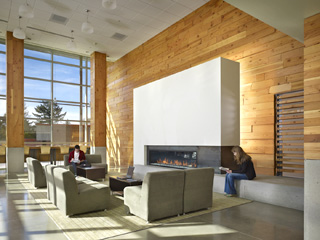|
Subscribe / Renew |
|
|
Contact Us |
|
| ► Subscribe to our Free Weekly Newsletter | |
| home | Welcome, sign in or click here to subscribe. | login |
Construction
| |
 |
November 18, 2010
In new WSU dorm, each floor is a neighborhood
Mithun

van der Veen
|

Frank
|
Olympia Avenue is the first new student housing development at Washington State University since 1972.
The six-story building is a place where students can connect with each other and with nature in a healthy, sustainable living and learning environment.
Olympia Avenue’s landscape design reintroduces native Palouse vegetation for the first time in a century. The design team used ponderosa pines to create a forest atop a rolling meadow that meets with the building’s open plaza, infusing the busy campus environment with an abundance of soft natural spaces.
Careful attention was given to the orientation of the building, which maximizes natural views by taking advantage of gently sloping topography. A classic rectangular shell, the building optimizes solar shading in the summer and passive solar gain in the winter — strategies that provide sweeping natural views while reducing energy costs and the size of the mechanical equipment.
Olympia Avenue’s main lounge and first-floor classrooms reinforce this interplay between campus buildings and nature. Large sliding doors open directly onto an outdoor plaza while a large fireplace provides an inviting space during cold months. Framed by wood paneling reclaimed from nearby abandoned barns, the fireplace reflects the area’s agrarian character.
Creating connection
The design team gained vital information during charrettes with students and staff, which dramatically reshaped the building’s interior architecture. Based on the students’ desire for more traditional living spaces, the design team employed several strategies that create spaces for connection throughout the building, including a media center, a variety of active and passive lounges, and community bathrooms — a specific and surprising request.
Building on the concept of community gathering, each floor is designed as its own small “neighborhood,” with a mixture of apartments, two- and four-bed suites and traditional residence hall rooms centered around wide day-lit “main street” corridors. Conversation nooks tucked along the main corridors encourage informal gathering.
Each residential floor includes passive study lounges as well as active community rooms. A grand connector staircase creates a visual relationship from floor to floor. Quiet study lounges look toward the campus while active community rooms with kitchens face the Palouse landscape, a nod to student interaction and play.
Living sustainably

Olympia Avenue was designed to promote health and performance while reducing demand for energy and water. An adjacent intramural playfield serves as a geothermal well for building heating and cooling, and gray water is reused for on-site irrigation.
Since students are driven inside for long periods during the winter, the building was designed to provide good indoor-air quality through individual environmental controls and monitoring, and the use of low-VOC materials, many of which are recycled or reclaimed locally.
The building also features a series of colorful icons that serve as visual cues for each sustainable strategy at work, from energy and water systems to site design and recycling programs. Each set of graphics relates to the six categories of LEED certification. For instance, graphics in the bicycle storage room illustrate the carbon savings and calories used when riding a bike to different campus locations and the surrounding community.
These educational markers encourage students to explore how their residence hall functions and to begin to define for themselves what it means to live sustainably by understanding their own daily lifestyle choices.
Olympia Avenue’s opening in August was the first milestone in WSU’s plan to create a world-class campus that integrates student life, sustainability and the picturesque Palouse countryside. The building is in process of attaining LEED gold certification.
Ron van der Veen, a principal with Mithun, is a founding board member for the Association for the Advancement of Higher Education. Gabriela Frank, an associate at Mithun, is a 2010 fellow of the Northwest Institute for Architecture and Urban Studies in Italy.
Other Stories:
- Have a campus project? Look out for trees
- Budgets dwindle, but master planning goes on
- Renovation ensures a campus hub for years to come
- Top 10 WSU projects
- Top 10 UW projects
- Veterinary medical building: a melting pot for research
- Historic warehouse gets an academic makeover
- UW's Foster business school built on connections
- UW ramping up $833M housing plan



